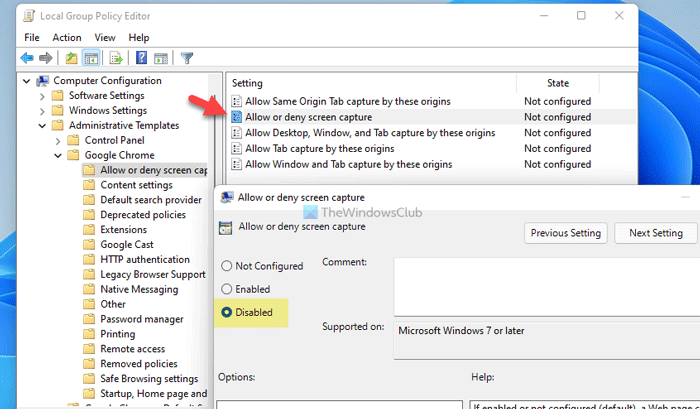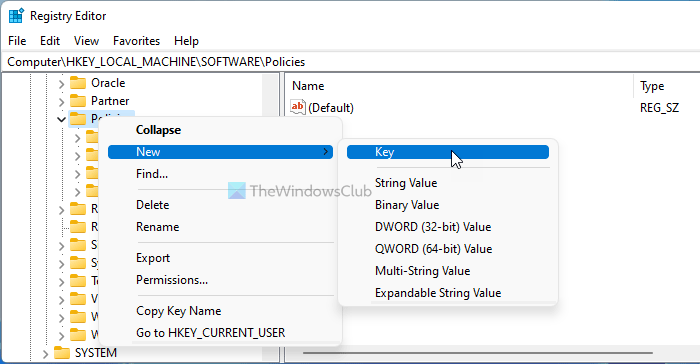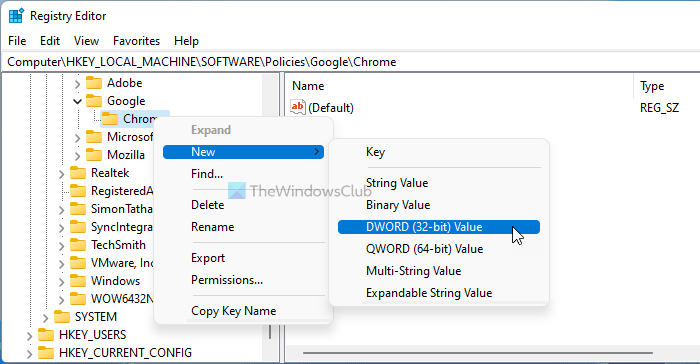Some websites often use the getDisplayMedia() or the Desktop Capture extension API to capture the screen. In some situations, it can be intimidating if you engage in some confidential or banking work using the Google Chrome browser. If you wish, you can block the screen capture on Google Chrome using the Registry or Group Policy Editor.
How to allow or block screen capture on Google Chrome using GPO
To allow or block screen capture on Google Chrome using the Group Policy Editor on Windows 11/10, follow these steps. To use the GPEDIT method, you must install the Group Policy template for Google Chrome first. You can download the template from chromeenterprise.google.
- Press Win+Rto open the Run prompt.
- Type gpedit.msc and press the Enter button.
- Navigate to Allow or deny screen capture in the Computer Configuration.
- Double-click on the Allow or deny screen capture setting.
- Choose the Disabled option.
- Click the OK button.
To learn more about these steps, continue reading.
At first, you need to open the Local Group Policy Editor on your computer. For that, press Win+R to display the Run prompt, type gpedit.msc, and hit the Enter button. Then, navigate to the following path:
Computer Configuration > Administrative Templates > Google Chrome > Allow or deny screen capture
Here you can find a setting called Allow or deny screen capture. You need to double-click on this setting and choose the Disabled option.

Then, click the OK button to save the change.
However, if you want to allow the screen capture, you need to open the same setting and choose the Not Configured or Enabled option.
For your information, you can allow some origins to capture your screen on Google Chrome. In other words, only specified origins can capture your Google Chrome screen. For that, you need to open the Allow Desktop, Window, and Tab capture by these origins setting, choose the Enabled option and enter an origin like this:
- ScreenCaptureAllowedByOrigins
- WindowCaptureAllowedByOrigins
- TabCaptureAllowedByOrigins
- SameOriginTabCaptureAllowedByOrigins
Once done, click the OK button to save the change.
Allow or block screen capture on Google Chrome using Registry
To allow or block screen capture on Google Chrome using Registry, follow these steps:
- Press Win+Rdisplay the Run dialog.
- Type regedit and hit the Enter button.
- Click the Yes option.
- Navigate to Policies in HKLM.
- Right-click on Policies > New > Key.
- Name it as Google.
- Right-click on Google > New > Key.
- Set the name as Chrome.
- Right-click on Chrome > New > DWORD (32-bit) Value.
- Name it as ScreenCaptureAllowed.
- Restart your computer.
Let’s check out these steps in detail.
First, you need to open the Registry Editor. For that, press Win+R > type regedit and hit the Enter button. If the UAC prompt appears, click on the Yes button.
Then, navigate to the following path:
HKEY_LOCAL_MACHINE\SOFTWARE\Policies
Here you need to create a sub-key. For that, right-click on the Policies key, select New > Key, and set the name as Google.

Then, right-click on the Google key, select New > Key, and name it Chrome. Following that, you need to create a REG_DWORD value. To do that, right-click on the Chrome key, select New > DWORD (32-bit) Value, and name it as ScreenCaptureAllowed.

By default, it carries a Value data of 0, and you need to keep it that way to block screen capture on Google Chrome. However, if you want to allow it, you need to double-click on this REG_DWORD value and set the Value data as 1.
Then, click the OK button and restart your computer. Alternatively, you can also delete the REG_DWORD value as well. For that, right-click on the ScreenCaptureAllowed, select the Delete option and click the Yes button.
Like the GPEDIT method, you can allow some origins to allow the screen capture in Chrome. For that, you need to right-click on the Chrome key, select New > Key and name it as TabCaptureAllowedByOrigins. Then, right-click on the TabCaptureAllowedByOrigins key > New > String value, and name it as 1.
Double-click on it to set the Value data as origin names. For your information, we have already mentioned the origins above.
Read: How to prevent Chrome from asking for Geolocation.
How do I block screenshots on Windows?
Some apps can take screenshots with or without the user’s consent. Microsoft respects the privacy of its users. That’s why it allows users to configure Windows settings so that they can prevent apps from taking screenshots on their systems. Snipping tool is software in Windows 11/10 that lets users take screenshots. If you have a shared computer, this tool can harm your privacy because another user can screenshots on your system. Windows 11/10 also has the option to disable Snipping Tool or Print Screen.
Why can’t I take a screenshot on PC?
You cannot take screenshots on a PC if the snipping tool or PrintScreen is disabled. You can check this in Windows Registry Editor or Group Policy Editor. If the Registry key is not modified or any policy is not set for the Snipping tool or PrintScreen, the problem lies somewhere else. Maybe some other programs are conflicting with the Snipping tool. Troubleshoot in a Clean Boot state to check this.
That’s all! Hope this guide has helped you.
Read: Browser extensions to take a Screenshot in Chrome and Firefox.
Leave a Reply